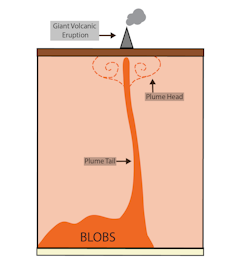Where do giant volcanic eruptions come from? New study finds missing link to ŌĆśblobsŌĆÖ deep within Earth
- Written by Nicolas Flament, Associate Professor and ARC Future Fellow, Environmental Futures, School of Science, University of Wollongong

Volcanic eruptions at EarthŌĆÖs surface have significant consequences. Smaller ones can scare tourists on Mount Etna or disrupt air traffic.
Giant, large-scale eruptions can have more serious impacts. One such event contributed to the demise of the dinosaurs 66 million years ago. Giant volcanoes also triggered events that led to the largest mass dying on Earth, the PermianŌĆōTriassic extinction 252 million years ago).
But what fuels a giant eruption, and how does it make its way to the surface from deep within the planet?
In a new study published in Communications Earth and Environment, we show that columns of hot rock, which rise some 3,000 kilometres through EarthŌĆÖs mantle and cause giant eruptions, are connected to continent-sized source regions we call BLOBS.
Hidden blobs within Earth
BLOBS are hot regions at the bottom of EarthŌĆÖs mantle (between about 2,000km and 3,000km in depth) which might be composed of different material compared with the surrounding mantle rocks.
Scientists have long known about these two hot regions under the Pacific Ocean and Africa. Geologist David Evans from Yale University suggested the acronym BLOBS, which stands for Big LOwer-mantle Basal Structures.
These BLOBS have possibly existed for hundreds of millions of years. It is unclear whether theyŌĆÖre stationary or if they move around as part of mantle motion (called convection).
Mantle plumes were the implicit link in previous studies relating BLOBS to giant volcanic eruptions. Their shape is a bit like a lollipop: the ŌĆ£stickŌĆØ is the plume tail and the ŌĆ£candyŌĆØ is the plume head.
Mantle plumes rise very slowly through the mantle because they transport hot solid rock, not melt or lava. At lower pressures in the uppermost 200km of EarthŌĆÖs mantle, the solid rock melts, leading to eruptions.
A long-sought relationship
In our new study, we simulated mantle convection from 1 billion years ago and found that mantle plumes rise from moving BLOBS and can sometimes be gently tilted.
Giant volcanic eruptions can be identified by the volume of volcanic rocks preserved at EarthŌĆÖs surface. The ocean floor preserves detailed fingerprints of mantle plumes for the past 120 million years or so (there is not much seafloor older than that).
Oceanic plateaus, such as the Ontong Java-Manihiki-Hikurangi plateau currently in the southwest Pacific Ocean, are linked to plume heads. In contrast, series of volcanoes such as the Hawaii-Emperor seamount chain and the Lord Howe seamount chain are linked to plume tails.
We used statistics to show that the locations of past giant volcanic eruptions are significantly related to the mantle plumes predicted by our models. This is encouraging, as it suggests that the simulations predict mantle plumes in places and at times generally consistent with the geologic record.
Model BLOBS, plume tails, and giant volcanic eruptions under the African hemisphere from 300 million years ago. BLOBS are coloured in dark red and plume tails are coloured by depth in yellow to orange tones, with warmer colours at greater depths. At the surface, the outlines of continental blocks are shown in transparent grey, and giant volcanic eruption locations are shown as green triangles.Are BLOBS fixed or mobile?
We showed that the considered eruption locations fall either onto or close to the moving BLOBS predicted by our models. Eruption locations slightly outside moving BLOBS could be explained by plume tilting.
We represented fixed BLOBS with 3D images of EarthŌĆÖs interior, created using seismic waves from distant earthquakes (a technique called seismic tomography). One out of the four seismic tomographic models that we considered matched the locations of past giant volcanic eruptions, implying that the fixed BLOBS scenario cannot be ruled out for geologically recent times ŌĆō the past 300 million years.
One of the next steps for this research is to explore the chemical nature of BLOBS and plume conduits. We can do so with simulations that track the evolution of their composition.
Our results suggest the deep Earth is dynamic. BLOBS, which are some 2,000km below EarthŌĆÖs surface, move hundreds of kilometres over time, and are connected to EarthŌĆÖs surface by mantle plumes that create giant eruptions.
To take a step back and keep things in perspective: while deep Earth motions are significant over tens of millions of years, they are generally in the order of 1 centimetre per year. This means BLOBS shift in a year at roughly the rate at which human hair grows each month.
Correction: this article has been amended to clarify the growth rate of human hair.
Authors: Nicolas Flament, Associate Professor and ARC Future Fellow, Environmental Futures, School of Science, University of Wollongong



















